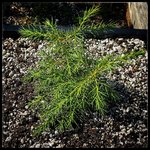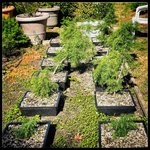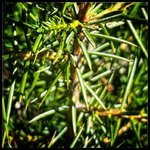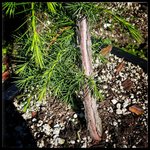CapeCodBonsai
Mame
I purchased 12 Needle Junipers (Juniperus rigida) last summer from an online nursery because I couldn’t find (and probably couldn’t afford) a finished Tosho Bonsai. The shipment was reported lost but, after many phone calls and complaints, it was eventually located. The boxes finally arrived (crushed) weeks later and the young trees were in pretty bad shape. I had purchased the last of the nursery’s Needle Juniper stock so, no replacements were even available.
Having minimal bonsai experience and too intimidated to try anything else, I blended together a mixture of ProMix and pumice and attempted to slip-pot each juniper into its own individual Anderson Flat. The rootball completely fell apart during at least half of the up-pottings. I kept them watered and in the shade of a large maple for a couple of weeks. Not seeing any new growth and doubting my decision to keep them in shade, I moved them to a sunny spot in the garden. I watered and waited the rest of the growing season but, they looked pretty much the same.
I probably should’ve heeled-in the flats before the ground froze but, for whatever reason, I didn’t. I remember feeling hopeful because, it seemed like we were having a relatively mild Cape Cod winter . . . then the color change started. When they went purplish I said to myself, “don’t panic, the Google machine says bronzing is normal for junipers.” When they turned brown (not bronze like the pictures I’d referenced) I realized I had screwed up any chance of saving my ill fated allotment of rare trees.
Because Cape Cod juts out into the cold Northwest corner of the Atlantic Ocean, our Spring season is delayed and some years it seems to be skipped over completely. As the weather warmed in the northern hemisphere, the occasional video would appear on YouTube showing some guy in Japan starting Spring work on a Temple Juniper. Filled with envy and being a glutton for punishment, I would revisit my brown-needled junipers looking for any signs of life. Everything around them was experiencing bud-swell and eventually leafed out. I even walked my wife down the row a couple of times because I thought the brown needles were gaining a greenish tinge and I wanted confirmation that I wasn’t experiencing an illusion brought on by my desperate mind. Knowing that she’s the optimistic, nurturing type, I wasn’t buying into her enthusiastic “I think so’s”.
Finally, one sunny Saturday morning following a couple of days of spring rains, it caught my eye. On one of the smallest junipers, a lime green bud! One of the junipers had actually managed to survive! I could hear music and started doing that dance that Snoopy does with his nose turned up to the heavens. Soon, additional buds were popping and even spreading like Martian chicken pox to the other plants until all twelve needle junipers were covered in fresh new bright green bundles of needles.
Currently, as the month of June draws to a close, my needle junipers are looking lush. While I’m watering, I try to imagine how I might style each individual juniper. I have no illusions about the limitations of such young nursery stock. None of these temple junipers will see a show in my lifetime . . . if ever at all. Still, I would gain a lot of pleasure by starting them on the road to becoming a mame or shohin bonsai for some hobbyist in the future. There is very little information available in the English language on properly caring for Juniperus rigida. There is absolutely nothing available (that I can find) on their development into bonsai from nursery stock.
Often I see people recounting the experiences they’ve had with various American substitutions for actual Tosho when trying to answer questions specifically about Juniperus rigida. Although there are superficial similarities and some are even closely related, it is my understanding that the Temple Juniper (Juniperus rigida) is treated somewhat differently than the Common Juniper (Juniperus communis), Shore Juniper (Juniperus conferta), the Foemina Juniper (Juniperus chinensis var. 'Foemina') or the Mediterranean Prickly/Cade Juniper (Juniperus Oxycedrus)
So, my long winded, desperate plea is, if you are one of those few fortunate individuals that have experience developing and/or maintaining Juniperus rigida PLEASE share some of your precious knowledge and advice on my next move(s). My thought is to not touch them until next Spring after the buds are actively elongating to allow them to continue to gain strength. Then, mostly because I’m a coward, try potting up only a couple of trees into bonsai training pots with the appropriate mixture of bonsai soil. I won’t touch the foliage on my potted trees but, I believe I will clean up, trim branches, and wire some movement into the remaining trees in the flats after the buds have elongated.
I’m still trying to figure out:






Having minimal bonsai experience and too intimidated to try anything else, I blended together a mixture of ProMix and pumice and attempted to slip-pot each juniper into its own individual Anderson Flat. The rootball completely fell apart during at least half of the up-pottings. I kept them watered and in the shade of a large maple for a couple of weeks. Not seeing any new growth and doubting my decision to keep them in shade, I moved them to a sunny spot in the garden. I watered and waited the rest of the growing season but, they looked pretty much the same.
I probably should’ve heeled-in the flats before the ground froze but, for whatever reason, I didn’t. I remember feeling hopeful because, it seemed like we were having a relatively mild Cape Cod winter . . . then the color change started. When they went purplish I said to myself, “don’t panic, the Google machine says bronzing is normal for junipers.” When they turned brown (not bronze like the pictures I’d referenced) I realized I had screwed up any chance of saving my ill fated allotment of rare trees.
Because Cape Cod juts out into the cold Northwest corner of the Atlantic Ocean, our Spring season is delayed and some years it seems to be skipped over completely. As the weather warmed in the northern hemisphere, the occasional video would appear on YouTube showing some guy in Japan starting Spring work on a Temple Juniper. Filled with envy and being a glutton for punishment, I would revisit my brown-needled junipers looking for any signs of life. Everything around them was experiencing bud-swell and eventually leafed out. I even walked my wife down the row a couple of times because I thought the brown needles were gaining a greenish tinge and I wanted confirmation that I wasn’t experiencing an illusion brought on by my desperate mind. Knowing that she’s the optimistic, nurturing type, I wasn’t buying into her enthusiastic “I think so’s”.
Finally, one sunny Saturday morning following a couple of days of spring rains, it caught my eye. On one of the smallest junipers, a lime green bud! One of the junipers had actually managed to survive! I could hear music and started doing that dance that Snoopy does with his nose turned up to the heavens. Soon, additional buds were popping and even spreading like Martian chicken pox to the other plants until all twelve needle junipers were covered in fresh new bright green bundles of needles.
Currently, as the month of June draws to a close, my needle junipers are looking lush. While I’m watering, I try to imagine how I might style each individual juniper. I have no illusions about the limitations of such young nursery stock. None of these temple junipers will see a show in my lifetime . . . if ever at all. Still, I would gain a lot of pleasure by starting them on the road to becoming a mame or shohin bonsai for some hobbyist in the future. There is very little information available in the English language on properly caring for Juniperus rigida. There is absolutely nothing available (that I can find) on their development into bonsai from nursery stock.
Often I see people recounting the experiences they’ve had with various American substitutions for actual Tosho when trying to answer questions specifically about Juniperus rigida. Although there are superficial similarities and some are even closely related, it is my understanding that the Temple Juniper (Juniperus rigida) is treated somewhat differently than the Common Juniper (Juniperus communis), Shore Juniper (Juniperus conferta), the Foemina Juniper (Juniperus chinensis var. 'Foemina') or the Mediterranean Prickly/Cade Juniper (Juniperus Oxycedrus)
So, my long winded, desperate plea is, if you are one of those few fortunate individuals that have experience developing and/or maintaining Juniperus rigida PLEASE share some of your precious knowledge and advice on my next move(s). My thought is to not touch them until next Spring after the buds are actively elongating to allow them to continue to gain strength. Then, mostly because I’m a coward, try potting up only a couple of trees into bonsai training pots with the appropriate mixture of bonsai soil. I won’t touch the foliage on my potted trees but, I believe I will clean up, trim branches, and wire some movement into the remaining trees in the flats after the buds have elongated.
I’m still trying to figure out:
- When exactly and how much I can bend the trunks and branches???
- If, when, or how much I can trunk chop???
- Best bonsai soil mix???
- How much foliage can I safely remove???
- Techniques for compacting, backbudding, and increasing branching/ramification???
- (Basically everything else I should know about the species)






Last edited:
